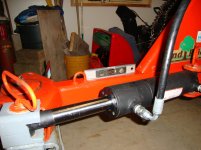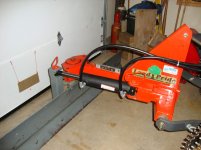In general, once you have the blade connected to the lower lift arms and the top link hooked up, raise the blade off the ground a couple inches. Now, with the tractor shut off, push the blade from side to side. It shouldn't move more than about an inch or two either way. If it does, shorten the side links equally until the blade is centered behind the tractor and there isn't much sway either way.
A rear blade can be a pig to hook up, I try to store mine on a couple of pieces of plank to hold it off the ground and level, level being the big thing. If it isn't level side to side, one pin is going to be lower than the other. I usually have to wrestle with it a little to line everything up.
To set the top link length, the main beam of the blade should be level with the blade just touching the ground as in the pictures. This is best done on a garage floor or somewhere that is level to begin with. If the blade is level side to side and fore and aft, the tips of the blade won't dig in too much when you angle the blade.
Without chains or loaded tires, the blade will want to swing the tractor around as you plow with the blade angled. I'd suggest taking several passes, removing about 4-6 inches of DEPTH each time.
The loader or snowblower is the best weapon for deep snow, but a rear blade works well on moderate stuff. You do need to get the right length pin for the top link, otherwise it'll fall out in the first ten minutes. Take the old one with you, to compare both length and diameter. It should be 3/4 inch diameter, but there's no guarantee it is.
While you're at TSC, stock up on 7/16 lynch pins, that's the most common size for CAT 1 hitches. Some use 3/8, but not many. You should have enough for all your implements, plus a couple of spares. I leave mine in place when I park an implement, then it's there when I go to hook up.
The hitch pins with the handles are worth their weight in gold, they give you some extra grip and leverage when things aren't perfectly lined up.
No seatbelt with the ROPS down, you want to get away from the tractor if it rolls in that condition. In all truth though, unless you're working somewhere that has limited overhead clearance, the ROPS should be up and locked, and your seatbelt ON. Snow clearing is particularly dangerous for rollovers, since ditches and other hazards are harder to see, you're often working from memory as to exactly where they are.
I always put the ROPS up when working the tractor, and the seatbelt goes on too in some situations. With hydraulic angle on the rear blade, I really have no excuse not to use the belt, since I rarely leave the operator's seat.
Sean

